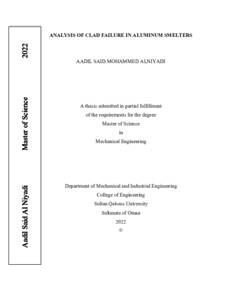وثيقة
Analysis of clad failure in aluminum smelters.
عناوين أخرى
تحليل فشل مفصل القطب في مصاهر الألمنيوم
الناشر
Sultan Qaboos University.
ميلادي
2022
اللغة
الأنجليزية
الملخص الإنجليزي
Most of the aluminum smelters around the world follow the Hall–Héroult process to
produce pure aluminum. The anode plant follows the Söderberg method to produce anodes
for the reduction line. A critical part in the anode is the Clad, also known as the Electric
Transition Joint (ETJ). This Clad is used to join the upper part of the stem (made of
aluminum) to the bottom part known as bracket (made of steel). The middle part of the
Clad consists of titanium which is explosion welded on one side and MIG welded on the
other, to provide a connection between the upper and lower parts. Some regional smelting
plants have reported repeated metal failure in the anode Clad. The defect of the Clad is
characterized as elongation or bending, and could be due to uneven stress distribution,
high heat, and high current. This Clad failure causes a tilt of more than 16⁰ in the stem,
leading to the failure of the smelting process. In one of the regional smelting plants, there
has been a rapid increase of Clad failure in recent years (not reported in earlier years).
This thesis work attempts to analyze the Clad failure problem in aluminum smelters,
identify the major causes, and suggest suitable remedial action. A thorough review of the
aluminum smelting process and affiliated problems was conducted. Different techniques
were identified and used to investigate the Clad failure problem, such as visual inspection,
X-ray inspection, chemical composition test, welding strength test, tensile test, shear test,
and finite element analysis (FEA). The Clad upper portion (from external supplier) was
found to be of good quality. Tensile tests and chemical composition tests of the aluminum
alloy yielded values that were well within the required range. The major causes of clad
failure were found to be lack of fusion, lack of penetration, and porosity in the welded
joints (from both visual inspections and X-ray inspections of sectioned samples). FEA of
different portions of the Clad with the welding layer (under mechanical, thermal, and
electrical loads) shows that in the case of good quality welding, the assembly can safely
withstand all applied loads without any failure. To mitigate this problem in the future, it
is strongly recommended that the welders should have superior welding skills (proper
licensing and experience of MIG welding), all welding parameters (current, welding
speed, inert shielding gas, etc) need to be strictly controlled, and environmental influences
need to be minimized (dust, humidity, etc).
المجموعة
URL المصدر
الملخص العربي
تتبع معظم مصاهر الألمنيوم حول العالم عملية Héroult-Hall إلنتاج الألمنيوم النقي. يتبع مصنع الأقطاب Anode) طريقة سودربيرج لإنتاج الأقطاب لخط الاختزال. تعتبر وصلة التيار الكهربائي جزء مهم في تركيب القطب، المعروف أيضا باسم مفصل الانتقال الكهربائي(ETJ (. يستخدم هذا المفصل لربط الجزء العلوي من الجذع المصنوع من الالومنيوم بالجزء السفلي المعروف بالقوس المصنوع من الفوالذ. يتكون الجزء الاوسط من المفصل من التيتانيوم وهو ملحوم بالانفجار. لتركيب المفصل في تركيبة القطب يستخدم لحام الغاز لتوفير اتصال بين الاجزاء العلوية ويستخدم لحام القوس الكهربائي لوصل التقوس السفلي. أبلغت بعض مصانع الصهر الاطقليمية عن فشل متكرر للمعادن في تركيبة المفصل. يتمثل عيب المفصل بالاستالاة والانحناء، ويمكن أن يكون ذلك ألسبا مثل توزيع الاجهاد غير المتكافئ والحرارة العالية والتيار الكهربائي العالي. يتسبب هذا الفشل المعدني في ميل يزيد عن 61 درجة للجذع العلوي من القطب، مما يؤدي إلى فشل عملية الصهر. في أحد مصانع الصهر الاطقليمية كانت هنالك زيادة سريعة في فشل المفصل في السنوات الاخيرة ولم يتم الابغا عنها في السنوات السابقة بسبب ان المفصل كان يعيش لفترته الافتراضية. هذا العمل البحثي هو لهدف تحليل مشكلة فشل المفصل في مصاهر الألمنيوم، وتحديد الاسبا الرئيسية لذلك واطقتراح الاجراءات العغاجية المناسبة. تم إجراء مراجعة شاملة لعملية صهر الالومنيوم والمشكغات المرتباة بها. تم تحديد واستخدام تقنيات مختلفة للتحقيق في مشكلة فشل المفصل، مثل الفحص البصري والفحص بالاشعة السينية واختبار التركيب الكيميائي للمفصل واختبار طقوة اللحام واختبار الشد بنوعين وطريقة النمذجة والمحاكاة باريقة العنصر المحدود (FEM(. تم العثور على ان الجزء العلوي المصنوع من الألمنيوم يتكون من نوعية جيدة تتناسب مع متالبات المصهر وأسفرت اختبارات الشد واختبارات التركيب الكيميائي لسبائك الالومنيوم عن طقيم كانت ضمن النطاق المطلوب . لكن تم العثور على الاسباب الرئيسية لفشل المفصل وهي نقص الانصهار وطقلة الاختراق والمسامية في الوصغات الملحومة من كل من عمليات الفحص البصري وفحوصات الاشعة السينية للعينات. وتوضح تحاليل المحاكاة ان الاجزاء المختلفة من المفصل بابقة اللحام ومع الاحمال الميكانيكية والحرارية والكهربائية تستايع تحمل جميع المتغيرات المابقة بدون أي عال. هذه الاطروحة تختتم ببعض الحلول للحد من هذه المشكلة في المستقبل، وتوصي بشدة أن يتمتع فني اللحام بمهارات لحام فائقة مع الترخيص المناسب والخبرة في لحام الغاز، ويجب التحكم بدطقة في جميع اساسيات اللحام من طقوة التيار وسرعة اللحام وغاز التدريع الخامل وما إلى ذلك مع التركيز على تجنب التأثيرات البيئية مثل الغبار والرطوبة إلخ.
قالب العنصر
الرسائل والأطروحات الجامعية

